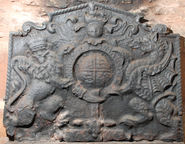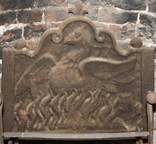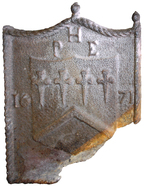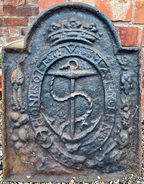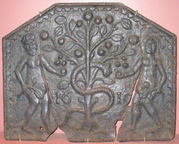-
959
Description: Arched shape; twisted rope edging (top and sides); top centre, shield of impaled arms; date above shield; initials, in triad ('F above), to right of shield.
Notes: The arms are of Sir Peter Frecheville (1575-1634) of Staveley Hall, Derbyshire, and his first wife, Joyce Osborne, née Fleetwood (d.1619), whom he had married in the year of the fireback's casting; the blazon is as follows: (Frecheville) Azure, a bend between six escallops argent; (Fleetwood) Per pale nebuly or and azure, six martlets, two, two and two counterchanged (the tinctures, as painted, are incorrect). At the bottom of the fireback there appears to be the remains of a runner by which the molten iron flowed into the sand mould.
Inscription: 1605 / PFI [triad]
Arms: Frecheville impaling Fleetwood
- Decoration tags:
- rounded arched (shape)
- rope (edging)
- whole carved pattern
- individual letters
- individual numbers
- armorial
- text
Manufactured: in 1605 probably at Staveley Furnace in the Derbyshire area of England.
Current location: Staveley Hall, Staveley Hall Drive, Staveley, Derbyshire, England.
- Attached to series:
- Personal armorial firebacks
- Date & initials firebacks
-
692
Description: Rectangular with inclined sides, joined by scrolls to a pedimented top; twisted rope edging (top and sides); Garter enclosing the Tudor royal arms, with crowned lion and dragon supporters, helm with chapeau and lion crest, and mantling; rectangular date compartment at base; initials either side of crest.
Notes: The detached pediment is stylistically typical of the late-16th and early-17th centuries. The use of a chapeau or cap of maintenance in place of a crown above the helm is rare in this period. There is an excrescence on the casting over the jaws of the dragon caused by the pouring of the molten metal disturbing the sand mould.
Inscription: E R / Garter motto / 160[?0]
Arms: Tudor royal - Elizabeth I
- Decoration tags:
- rectangular with detached pediment (shape)
- rope (edging)
- whole carved pattern
- individual letters
- individual numbers
- armorial
- royal
- text
Manufactured: in 1600 in England.
Current location: Cothay Manor, Stawley, Somerset, England.
- Attached to series:
- Elizabethan royal armorial firebacks
- Tudor royal armorial firebacks
-
693
Description: Canted rectangle; twisted rope edging (top and sides); a shield repeated five times, each bearing three arrows palewise, points down, with a molet (star) above the middle arrow, two over three.
Notes: Three arrows form the arms of several families, so identification of the arms is not possible without the associated colouring. The star is likely to be a mark of cadency, granted to a third son. Four rivets along the base may relate to earlier repair. The fireback was formerly at Chisenbury Priory, Wiltshire. A variant with three shields (W 740mm x H 480mm) was lot 530 at Brettells auction, Newport, Salop, 1 March 2022 and again as lot 457 on 2 May 2023.
Arms: Not known
- Decoration tags:
- rectangular with canted top corners (shape)
- rope (edging)
- carved stamps
- armorial
Manufactured: in the late-16th to early-17th century in England.
Current location: Cothay Manor, Stawley, Somerset, England.
- Attached to series:
- Personal armorial firebacks
-
1079
Description: Quasi-arched rectangular shape; fillet edging, indented on the inner edge; pictorial representation of a phoenix rising from flames, date split either side of its neck; the lateral edges are wide in relation to the top, from which the arch rises from two loop and is surmounted by a fleur-de-lys; above each shoulder of the plate, a roundel.
Notes: The looped fillet edging is rarely seen and does not seem to be diagnostic of a particular pattern-maker.
Inscription: 16 77
- Decoration tags:
- rectangular with ornate arch (shape)
- fillet (edging)
- whole carved pattern
- pictorial
- mythological
- text
- animals
Manufactured: in 1677 possibly in the Staffordshire area of England.
Current location: Ford Green Hall, Ford Green Road, Smallthorne, Stoke-on-Trent, Staffordshire, England.
(part of the Stoke-on-Trent Museums museum group)
- Attached to series:
- Miscellaneous pattern firebacks
- Phoenix firebacks
- Loop edged firebacks
-
1078
Description: Fragment; quasi-arched rectangular shape; twisted rope or leather edging; flame on centre arch and on top corners (left missing); initials in triad above central shield with date split either side of centre; the bottom right corner is missing.
Notes: The initials are of Philip Hollins (d. 1724) of Mosslee Hall, Cheddleton, Staffordshire, and his wife Elizabeth Bage whom he married in 1671. Blazon: Argent, a chevron azure, in chief four crosses formee fitchee of the second.
Inscription: PHE [triad] / 16 71
Arms: Hollins, of Mosslee Hall
- Decoration tags:
- rectangular (shape)
- rope (edging)
- whole carved pattern
- heraldic
- armorial
- text
Manufactured: in 1671 possibly in the Staffordshire area of England.
Current location: The Potteries Museum and Art Gallery, Bethesda Street, Stoke-on-Trent, Staffordshire, England.
Museum number: LH.SH.1955.21 (part of the Stoke-on-Trent Museums museum group)
- Attached to series:
- Personal armorial firebacks
-
694
Description: Arched shape with scrolled side brackets; astragal edging on arch; bipartite design with side pilasters and a central pilaster surmounted by two gothic traceried arches within each of which are two roses and two fleurs-de-lys; below left arch, letter ‘W’ (possibly ‘WY’ monogram) above first half of date; below right arch, shield bearing arms of the Borough of Stratford-upon-Avon above second half of date.
Notes: The combination of the monogram and the arms of Stratford suggest an individual with a formal office within the borough; a mixture of Gothic and Classical elements; damage to bottom right side.
Inscription: W [Y?] / 15 85
Arms: Borough of Stratford-upon-Avon
- Decoration tags:
- rounded arched (shape)
- astragal (edging)
- whole carved pattern
- individual letters
- individual numbers
- heraldic
- architectural
- text
Manufactured: in 1585 in England.
Current location: Nash's House, Chapel Street, Stratford-upon-Avon, Warwickshire, England.
(part of the Shakespeare's Birthplace Trust museum group)
- Attached to series:
- Miscellaneous pattern firebacks
- Date & initials firebacks
- Civic firebacks
-
695
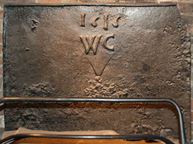 ? x ? mmImage subject to copyright
? x ? mmImage subject to copyrightDescription: Rectangular; fillet edging (top and sides only); top centre, date formed of individual letter stamps; below date, initials carved as single stamp, overstamped and showing v-shaped extension below.
Notes: The reason for the unusual shape of the base of the initial stamp is not understood.
Inscription: 1616 / WC
- Decoration tags:
- rectangular (shape)
- fillet (edging)
- carved stamps
- individual numbers
- text
Manufactured: in 1616 in England.
Current location: Nash's House, Stratford-upon-Avon, Warwickshire, England.
(part of the Shakespeare's Birthplace Trust museum group)
- Attached to series:
- Date & initials firebacks
-
696
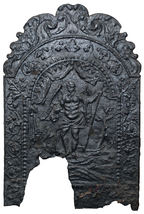 ? x ? mmImage subject to copyright
? x ? mmImage subject to copyrightDescription: Arched rectangular central panel with nutshell edging on a broad fillet; pictorial scene of a standing, winged male figure draped with a cloth, holding a staff in his left hand, above a ground, and with drapery over; arched rectangular border with fillet edging; alternating acanthus leaves with swirled tendrils; on top, two mirrored sea serpents.
Notes: Presumably intended to represent an angel; similarities in the design and execution of the pattern suggest the work of the pattern-maker identified as ‘N’ (q.v.); the missing segment had been filled with a piece from another fireback (removed in this photo).
Manufactured: in the early-18th century in England.
Current location: Nash's House, Stratford-upon-Avon, Warwickshire, England.
(part of the Shakespeare's Birthplace Trust museum group)
- Attached to series:
- British 'Dutch' style firebacks
- New Testament firebacks
-
1087
Description: Arched rectangular shape; cavetto-moulded edging; central fouled anchor within a Garter surmounted by a ducal coronet; fructal swags to each side.
Notes: The anchor may relate to the office of Lord High Admiral who, in the third quarter of the 17th century was James, Duke of York (afterwards King James II). Another example was sold at Christie's auction 12 Oct 2010 lot 109 (£500). A variant with a viscount's coronet is at Chastleton House, Oxfordshire.
Copies of this fireback are known.
Inscription: HONI SOIT QUI MAL Y PENSE
- Decoration tags:
- rectangular with round arch (shape)
- cavetto (edging)
- whole carved pattern
- heraldic
- text
- objects
Manufactured: in the mid- to late-17th century in England.
Current location: Stratford upon Avon, Warwickshire, England.
- Attached to series:
- Miscellaneous royal firebacks
-
697
Description: Canted rectangle; embattled, cavetto moulded edging; central tree with fruit and leaves, a snake, facing right, with a human face in profile entwined, in ‘S’ shape, around the trunk and lower branches; to the left, a naked, bearded male figure holding an apple in his left hand and a branch in his right for modesty; to the right a naked female figure with apple and branch also; the date split either side of the snake and tree trunk.
Notes: Similarities with an armorial in the date, numerals and edging suggest a common pattern-maker.
Copies of this fireback are known.
Inscription: 16 19
- Decoration tags:
- rectangular with canted top corners (shape)
- embattled cavetto (edging)
- whole carved pattern
- pictorial
- biblical
- text
- animals
- humans
- plants
Manufactured: in 1619 in England.
Current location: Stroud District Museum, Stroud, Gloucestershire, England.
Museum number: STGC 2371 (part of the Stroud Museum museum group)
- Attached to series:
- 1619 series
- Old Testament & Apocrypha firebacks
- Adam & Eve firebacks

